Well well, have you wonder where are those white striped or spotted hamsters you own or saw them? Well this week we are exploring them as they are known as coat patterns rather then individual colours. Coat patterns will show on all colours and some coat patterns can occur together. Some may be lethal, some will totally change the colour of the hamster itself.
Note:
Pictures are credited to original work of owners.
There are variations in terms of phenotype for hamsters. The pictorial illustrations are just general idea of how the hamsters looked like.
Descriptions are standards according to Midland Hamster Clubs.
Insufficient information on Piebald gene. If you are able to provide sufficient descriptions please send it to addeva@theonepet.com. Help is appreciated!
Pattern: Banded
Genotype: Baba/BaBa
Phenotype:
1. The white banded animal shall have the appearance of coloured animal with a superimposed white band. The white band shall completely encircle the body and be centrally placed and not skewed. The width shall be approximately one third of the body length, completely unbroken with sharply defined and parallel margins.
2. The belly fur shall be white.
3. The white areas shall be white to the roots.
4. The coloured areas shall conform to the recognised full colour variety.
Remarks: Avoid breeding with wh gene. Do note that broken bands are also banded.
Pattern: Dominant Spots
Genotype: Dsds
Phenotype:
1. The dominant spot shall have the appearance of a white animal with coloured spots. The spots shall be sharply defined and evenly distributed over the top surface of the animal.
2. The belly fur shall be white.
3. The white areas shall be white to the roots.
4. The coloured spots shall conform to the recognised corresponding full coloured variety.
Remarks: Avoid breeding with wh gene. Homozygous dominant (DsDs) Dominant Spot is lethal. Also known to be incomplete dominant.
*Credits to The River Road Hamstery
Pattern: Banded Dominant Spots
Genotype: BabaDsds/ BaBaDsds
Phenotype:
1. The Banded Dominant Spot hamster shall have the appearance of a dominant spot or piebald animal with a broad white band superimposed. The white band shall extend from the neck to the hips, ideally 2/3 of the body length, and contain no coloured markings. The head and the rump shall conform to the Dominant Spot or Piebald standard, (i.e. give the appearance of the white animal with coloured markings).
2. Coloured areas shall conform to the relevant colour standard. White areas shall be white to the roots.
3. Belly fur shall be white to the roots.
Remarks: Avoid breeding with wh gene. Homozygous dominant (DsDs) Dominant Spot is lethal.
Pattern: Piebald
Genotype: ss
Phenotype:
Remarks: May be extinct. Insufficient information.
Pattern: Tortoiseshell
Genotype: Toto
Phenotype:
1. Overall Appearance: A tortoiseshell is a bi-coloured animal which consists of a balanced pattern of coloured and yellow patches. These patches shall be clear and distinct with no brindling.
2. The coloured areas shall conform to the recognised full colour variety whilst the yellow shall be a rich creamy yellow when in combination with the golden, but shall be present in a diluted form when combined with other recognised colours. e.g.
|
Main Colour |
Yellow |
|
|
|
|
Golden |
Rich Apricot Yellow |
|
Dark grey |
Smoke pearl |
|
Cinnamon |
Honey |
|
Lilac |
LilacPearl |
Remarks: Presence of yellow and other form of colours. Yellow must be visible.
Pattern: Tortoiseshell and white
Genotype: TotoBaba/ TotoBaBa/ /TotoDsds
Phenotype:
1. Atortoiseshell is a sex-linked bi-coloured animal. The standard calls for a tricoloured animal which is produced by combining the tortoiseshell with a white pattern gene. The coat colour shall consist of a balanced pattern of coloured, yellow and white patches. These patches shall be clear and distinct with no brindling.
2. The coloured areas shall conform to the recognised full colour variety whilst the yellow shall be a rich creamy yellow when in combination with the golden, but shall be present in a diluted form when combined with other recognised colours. e.g.
| Main Colour | Yellow |
| Golden | Rich apricot yellow |
| Dark grey | Smoke pearl |
| Cinnamon | Honey |
3. The belly fur shall be white.
Remarks: Must be banded or dominant spotted, yellow and other form of colours. Only females can be tri-coloured. Instances where male are tri-coloured are most likely sterile. (will be explained further in future posts)
Pattern: Roan (Anophthalmic White)
Genotype: Whwh
Phenotype:
1. Overall Appearance: The Roan shall have the appearance of a white animal ticked with colour. The ticking shall be heavy around the head and give an evenly marbled appearance over the remainder of the top coat. The white areas shall be white to the roots. The coloured areas shall conform to the recognised coloured variety allowing for slight dilution.
2. The belly fur shall be marbled with colour.
Remarks: Avoid breeding pairs with wh genes. Homozygous dominant (WhWh) litters maybe born eyeless. Roan only applies to Self Coloured. wh(p), a recessive gene, will result in polywhite. Polywhite will give a poor roan colour.
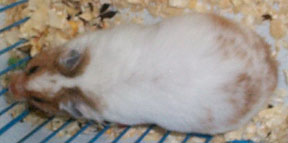
*Credits to The River Road Hamstery
Pattern: Recessive Dappled
Genotype: rdrd
Phenotype: Coloured head and white blaze and coloured butt
Remarks: May be seen with any colour and coatings. Shows more clearly on short haired.
I had also updated a new colour to Part 2 (Self Colour) – be amazed by the colour Blue. Well next post will be the last of ‘What Colours to Choose? Part 4 (Coat types)

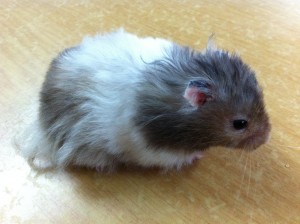
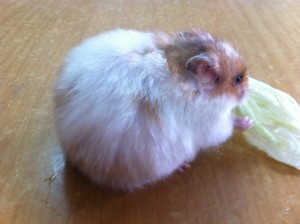
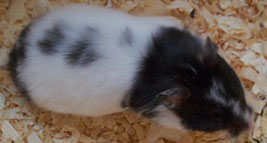
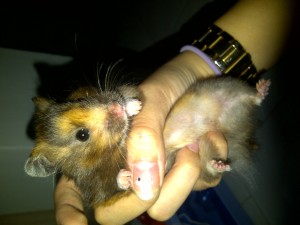
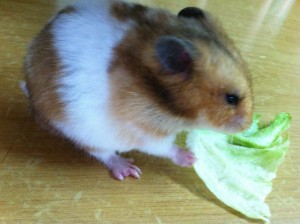
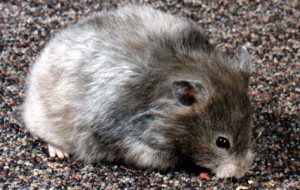


3 Responses
Fantastically revealing cheers, I presume your current visitors would possibly want a whole lot more articles of this nature preserve the great content.
Magnificent goods from you, man. I have understand your stuff previous to and you’re just too fantastic. I really like what you have acquired here, really like what you’re saying and the way in which you say it. You make it entertaining and you still care for to keep it sensible. I can’t wait to read much more from you. This is actually a tremendous website.
Thank you!